1. Introduction
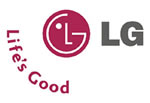 Today we will be reviewing one of the two LG latest releases in External Recorder drives, the GSA-5169D. From our first encounter with the drive, it seemed like just another external device, with MultiReading/Writing capabilities, and the usual array of standard features. But the 5169D offers one more feature, OneTouch Recording, which enables the end user to capture videos directly to the media from AV supported devices. It should be noted that the 5169D cannot work as a stand alone video capture device and requires a PC in order for the feature to work.
Today we will be reviewing one of the two LG latest releases in External Recorder drives, the GSA-5169D. From our first encounter with the drive, it seemed like just another external device, with MultiReading/Writing capabilities, and the usual array of standard features. But the 5169D offers one more feature, OneTouch Recording, which enables the end user to capture videos directly to the media from AV supported devices. It should be noted that the 5169D cannot work as a stand alone video capture device and requires a PC in order for the feature to work.
Other than that, the drive is being a multi, offering 16X/16X burning speeds for DVD±R media, 8X/4X for DVD±R DL media, 8X/6X for DVD±RW media and the traditional 5X DVD-RAM writing and reading speed. Let's have a look at the full specifications...
- Specifications
| Model |
LG GSA-5169D |
| Write/Read Speed |
Write: DVD+R 16x / DVD+R DL 8x DVD-R 16x / DVD-R DL 4x DVD+RW 8x / DVD-RW 6x DVD-RAM 5x / CD-R 48 CD-RW 32x Read: (CD-ROM) Max 48x, (DVD-ROM) Max 16x |
| Data Transfer Rate |
CD: 7,200KB/s DVD: 22.16 Mbytes/s |
| Access Time |
CD: 120 ms, DVD-ROM 175ms, DVD-RAM 250ms |
| Buffer size |
2MB with buffer under run prevention technology |
| Loading Type |
Motorized Tray |
| Interface type |
USB 2.0 (requirement for AV capture), AV input |
| Write Method |
(DVD-R/RW) Disk-at-Once, Incremental Recording Restricted Overwrite (DVD-RW only), (DVD+R) Sequential Recording, (DVD+R/-R DL) Sequential Recording, (DVD+RW/RAM) Random Write (CD-R/RW) Disk-at-Once, Track- at-Once, Session-at-Once, Packet Write |
| System Requirements |
PU : Pentium III 800MHz of faster (or equivalent) (Recommended for optimal performance: P IV 2.4GHz) Pentium IV 1.6GHz or faster is required for AV capture RAM : 256MB or larger (Recommended: 512MB) HDD : 10GB (DVD±R DL : 16GB) or more space Video memory : 32MB(Recommended: 64MB) Direct X 9.0 or higher Interface: USB 2.0 |
| AV Capture |
Receive Video(S-Video) and Audio analog signal Video Encoding Standard : MPEG-2, MPEG-1 Data Multiplexing : MPEG-2 (ISO/IEC 13818-1) Audio Compression : Read : MPEG-1,MPEG-2 Write : MPEG-1, MPEG-2, Layer-2 Video Type : NTSC / PAL Video Format : VCD / SVCD / DVD /AVI Supported Capture Recording disc : CDR, CD-RW (VCD/ SVCD), DVD±R, DVD±RW, DVD±R DL (DVD) |
| WxDxH (mm) |
160 x 230 x 50(mm) |
| Weight (kg) |
1370g +/- 30g (net) |
| OS Compatibility |
Windows XP Home & Prof. (SP1. SP2) |
Below are the drive's main specs as given by NeroInfoTool, DVDInfoPro and VSO inspector:
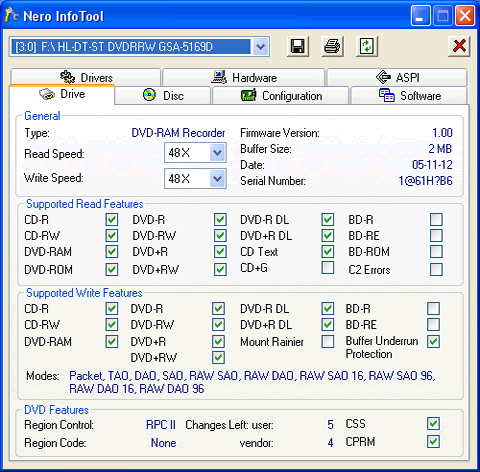


- Retail package

The retail package contains everything for the average user to get started. So, apart from the Nero OEM suite and Cyberlink applications, there's an extra CD with the OneTouch software. Note here, that the box, apart from the USB and Power Supply cables, does not contain any other cables, so don't expect to find Audio-Video-SVideo cables bundled. You'll have to buy these cables separately.
-The Drive
The front bezel is divided into two sections. The upper (tray) features the Super Multi logo, +RDL logo, LG trademark and DVD Multi logo. The lower section has the eject button (far right), the emergency eject hole, the activity LED and the OneTouch button (far left).

Now, this is one rear panel that we don't see all that often. As you can clearly see, it features the left and right audio outputs, composite video output and S-Video output. The interface with the PC is through the USB 2.0 connection, located next to the power supply input jack.

- Installation
The drive was installed under WindowsXP and was
recognized as "HL-DT-ST DVDRRW GSA-5169D ". The drive came with the default firmware installed and since no further firmware releases had been issued, we moved straight on to the tests.
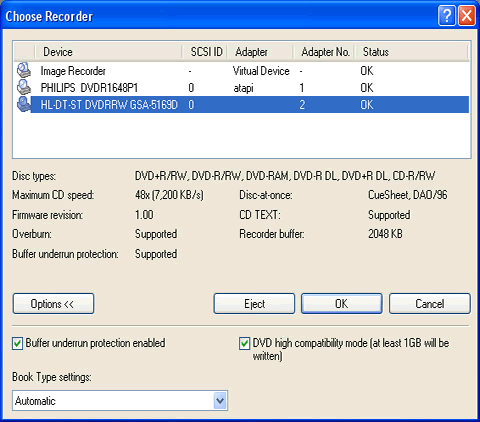
For the needs of this review, we will be comparing the results of the 5169D along with those of the Samsung SE-W164C and LiteOn 1653S Xternal drives. Now let's move on to the next page and investigate the reading capabilities of the drive with CD and DVD media, as well as the video ripping capabilities.
2. Reading Tests
- CD Format
 As with all latest release drives, the LG 5159D supports up to 48X reading speed for CD media and up to 32X for RW media. We used both media types to verify the drive's reading speed, using the CD-DVD Speed utility. Here's what we got.
As with all latest release drives, the LG 5159D supports up to 48X reading speed for CD media and up to 32X for RW media. We used both media types to verify the drive's reading speed, using the CD-DVD Speed utility. Here's what we got.


All three drives had more or less similar performance when using Pressed CD media, reporting close average and end speeds. On the other hand, the Samsung drive managed to outpace the other two drives when it came to HS-RW media, due to its higher supported speed with the specific format.
- AudioCD
For these tests, we used a pressed AudioCD and the Advanced DAE CDSpeed feature.
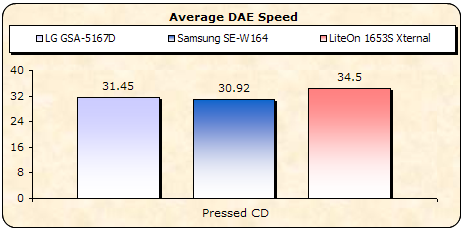

As we can see from the Average DAE Speed test, the drive performed was slightly slower than the other two drives. As the CD-Speed Advanced DAE Quality test reports, the drive was awarded 100 quality score and an average DAE speed of 28.65X, while it supports Leadin, as well as CD Text and Subchannel Data.

- 90mins Audio disc

- 99mins Audio disc

Unfortunately, the drive could not read the 90mins Audio disc, but it managed to successfully read all the way to the end the 99min Audio disc, even though reading was accomplished at very low speeds.
- DVD Format
 We repeated the reading tests, this time using a collection of pressed SL and DL DVD media to test the drive's reading capabilities with DVD media and posted the results in the following graphs.
We repeated the reading tests, this time using a collection of pressed SL and DL DVD media to test the drive's reading capabilities with DVD media and posted the results in the following graphs.

All three drives support up to 16X reading speed with Pressed SL media. Only the LiteOn drive did not reach the maximum speed, falling short at 14.2X end speed.
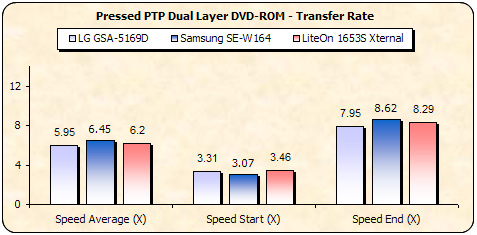
The two layers of a PTP DVD-ROM disc are read sequentially with the drive starting reading from the inner part of the disc, which is the beginning of each layer, progressing towards the outer range, for each layer. Max supported speed for this media was 8X for all drives.

The graph shown above indicates the reading performance of the drive with OTP dual layer media. The first layer of an OTP dual layer DVD-ROM is read exactly the same way as the first layer of the PTP disc we tested previously. The difference here is the reading strategy of the second layer of the disc. The beginning of the second layer is located in the outer part of the disc, so the drive starts reading from the outer tracks towards the inner part of the disc. Again, all three drives support 8X max reading speed with DL media.

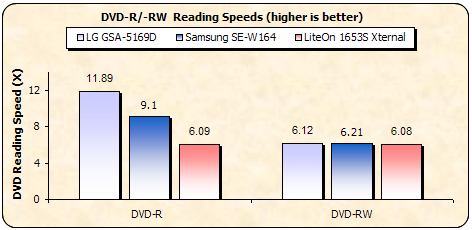
With WriteOnce media, the reviewed drive reached 12X average reading speed, thanks to its ability to read write once media at 16X max, while the next best was the Samsung drive at 9X. With ReWriteable media, all three drives, reported similar average speeds around 6X.
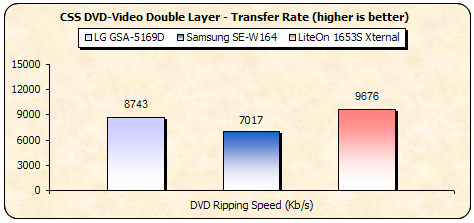
The reported ripping speed for the LG drive was 8743Kb/s or 6.6X ripping speed, approx.
- DVD-RAM
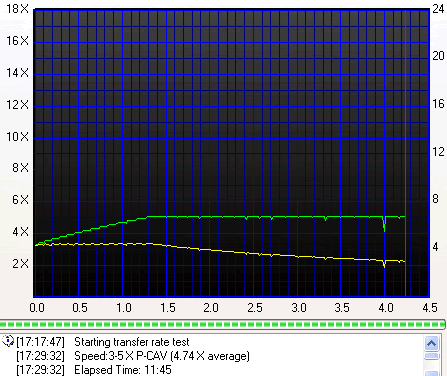
As with most Multi drives, the LG 5169D can read DVD-RAM at a max speed of 5X.
Overall, the LG GSA-5169D is a good reader, with the ability to read WriteOnce media (non pressed) at a speed of up to 16X, so it is ideal for DVD reading. Unfortunately, with DL media, the drive cannot offer the same performance.
- Appendix
Nero CD-DVD Speed Graphs
3. CD Error Correction
In the following tests, we check the drive's behavior when it comes to reading
scratched / defective discs. The test discs we use are the ABEX series
from ALMEDIO.
- ABEX TCD-721R


|
Errors total |
Num: 837003 |
|
Errors (Loudness) dB(A) |
Num: 50717 |
Avg: -74.7 dB(A) |
Max:-10.6 dB(A) |
|
Error Muting Samples |
Num: 2718 |
Avg: 1.1 Samples |
Max: 83 Samples |
|
Skips Samples |
Num: 1 |
Avg: 6.0 Samples |
Max: 6 Samples |
| Total Test Result |
73.3 points (of 100.0 maximum) |
What we have here is average performance. The total error count is low and most of the error loudness level is below -36 dB(A). However, there was one sample skipped. The total test result score is 73.3.
- ABEX TCD-726


|
Errors total |
Num: 0 |
|
Errors (Loudness) dB(A) |
Num: 0 |
Avg: -174.0 dB(A) |
Max: -174.0 dB(A) |
|
Error Muting Samples |
Num: 0 |
Avg: 0 Samples |
Max: 0 Samples |
|
Skips Samples |
Num: 0 |
Avg: 0 Samples |
Max: 0 Samples |
|
Total Test Result |
100 points (of 100.0 maximum) |
Flawless reading of the 726 test media. 100 points for the total test result score.
- CD-Check Audio Test Disc
 The CD-Check Test Disc is a very useful tool for evaluating the Sound Reproduction
/ Error correction capabilities of a CD player. The disc offers a signal combination
with disc error patterns to rate the drive's ability to read music and reproduce
it completely. Five tracks on the disc contain a sequence of progressively
difficult tests. These tracks are referred as Check Level -1 through Check
Level -5.
The CD-Check Test Disc is a very useful tool for evaluating the Sound Reproduction
/ Error correction capabilities of a CD player. The disc offers a signal combination
with disc error patterns to rate the drive's ability to read music and reproduce
it completely. Five tracks on the disc contain a sequence of progressively
difficult tests. These tracks are referred as Check Level -1 through Check
Level -5.
The
tracks are reproduced (played) through a software multimedia player
(i.e. Windows Media Player). Each level is considered as passed, if the tone
coming
out
from the speakers is smooth, continuous without interruptions, skipping or
looping. The higher the Check Level passed, the more reliable the sound reproduction
of the tested device.
|
Error Level |
1 |
2 |
3 |
4 |
5 |
|
LG GSA-5169D |
5/5 |
5/5 |
5/5 |
0/5 |
0/5 |
Average performance reported, with the drive managing to read the third error level without flaws. From the fourth level and up, audible clicks were present.
Overall, average CD error correction from the 5169D.
4. DVD Error Correction
In the following tests, we examine the DVD reading capabilities of
the LG GSA-5169D drive with scratched / defective
DVD media.
For the tests we used CDVD Benchmark and Nero CDSpeed. The reference test
media
comes
from
ALMEDIO.
- Single Layer media
ABEX TDR-821
This is a single sided, single layer DVD-ROM with 4.7GB capacity, and its
surface has an artificial scratch of dimensions varying from 0.4 to 3.0 mm.
The following transfer rate picture comes from the CDVD Benchmark v1.21 transfer
rate test.


Reaching a max speed of just under 9X, the drive managed to read this test media without any trouble.
ABEX TDR-825
This is also a single sided, single layer DVD-ROM of 4.7GB capacity. The
data structure of the disc is exactly the same as that of the TDR-821, with
the difference that there are no scratches on it but instead, defective areas
of dimensions ranging from 0.5 to 1.1 mm. There are also fingerprints sized
between
65 and
75 micrometers.


Once more, the max reading speed while reading this defective media was a little under 9X. The drives starts off at a fairly high reading speed and reaches max very early on. There is quite a lot of deviation in speed (scattered yellow dots) but these are not the result of the defect areas. In any case, the reading process completed without any errors being reported.
- Dual Layer media
ABEX TDR-841
This is an 8.5GB dual layer, single sided DVD-ROM disc with artificial scratches
of dimensions ranging from 0.4 to 3.0mm, on both layers.

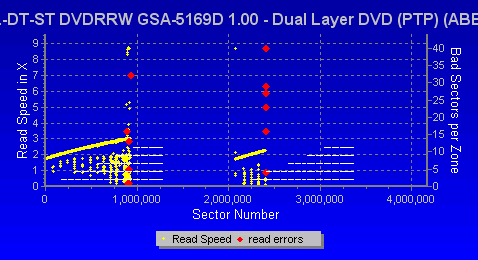
In this case, we were surprised to see that the 5169D did not manage to read this media, reporting numerous read errors. This performance was not expected and we haven't encountered a drive, incapable of reading this test media, even at low speeds. This is an issue that should be looked into by LG. Note here, that we double and triple checked the reading, to verify that it was the drive's error correction mechanism that failed and not the media itself.
ABEX TDR-845
This test disc is a single sided, dual layer DVD-ROM disc with a capacity
of 8.5GB. The only difference between the TDR-845 and the TDR-841 discs is
that the first includes
defective areas and fingerprints. The dimensions of the defective areas ranges
from 0.5 to 1.1 mm and the fingerprints are sized from 65 to 75 micrometers.
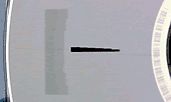
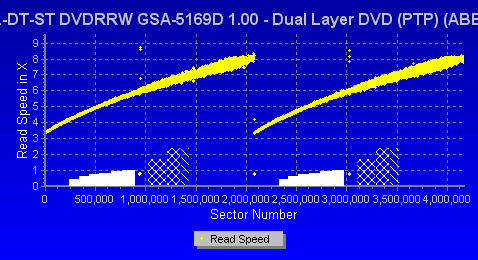
The drive managed to successfully read past the artificially defective areas on this dual layer test disc. Max reading speed was 8X for both layers. No errors or drops of speed were reported.
ABEX TDV-541
The TDV-541 is a single sided, dual layer DVD-VIDEO disc, with a capacity
of 8.5GB. The disc is based on the TDV-540 series which is designed for inspection
and adjustment of DVD-VIDEO players. The disc checks the layer switch operation
from layer 0 to layer 1 and also includes test pictures and test signals for
DVD sound files. The current TDV-541 also checks the error correcting
capabilities of the drive and includes scratches from 0.4 to 3.0 mm.

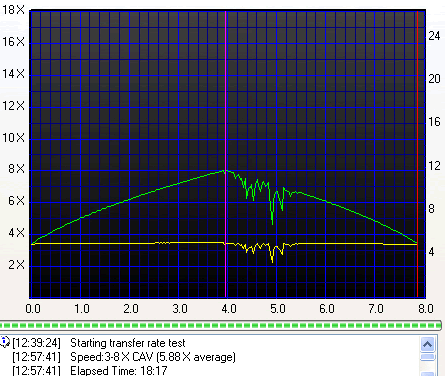
Good performance with the 541 test media. Max reading speed was 8X and apart from the glitch after the start of the second layer, all reading progressed smoothly.
ABEX TDV-545
The
TDV-545 disc is based on the TDV-540 series. It is a single sided, dual layer
DVD-VIDEO disc with a capacity of 8.5GB. The TDV-545 includes artificial black
dots on the data surface, sized from 0.4 to 1.0 mm. It also has 65 - 75
micrometer fingerprints.

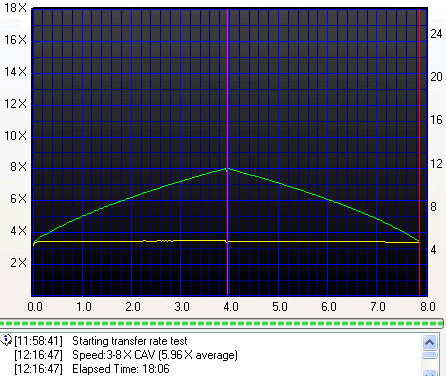
Smooth reading all the way to the end.
- Conclusion
Somewhat slow, but does the job. The GSA-5169D could have been a good DVD reader (DVD-Error Correction mechanism) but this is not the case, since it failed to successfully read the 841 test media. As already stated, we have not encountered such a poor performance with the specific test media. This is an issue that should be looked into by LG and we hope for a fix soon.
5. Protected Discs
At this point, we will check the drive's ability to read and backup protected CDs.
- AudioCD protections
 For the test procedure we used three audio discs with different audio copy protections. The ripping process on all protected Audio discs was carried out with Exact Audio Copy v0.9 beta5.
For the test procedure we used three audio discs with different audio copy protections. The ripping process on all protected Audio discs was carried out with Exact Audio Copy v0.9 beta5.
The protected Audio discs tested, were:
| Audio Discs |
Protection |
| Celine Dion - New Day Has Come |
Sony's Key2Audio |
| Natalie Imbruglia - White Lilies Island |
Cactus Data Shield 200 |
| Aiko Katsukino - The Love Letter |
Cactus Data Shield 200.0.4 - 3.0 build 16a |
The Cactus Data Shield 200, contains artificial errors that are not easily bypassed by the reader, while the Key2Audio contains a second session causing problems to readers when trying to read the Table Of Contents (TOC).
The tested tasks are:
- Recognition of the inserted disc (Yes/No).
- Ripping all wav files(with EAC's Burst Mode) to the hard disk through copy&compare function.
- Listening to the produced wav files to detect any possible click/skips.
The drive recognized up to the 12th Audio track in the CDS200 disc,

and with the "Retrieve Native TOC" option removed, the drive recognized the 13th track.
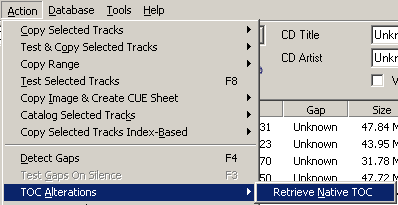
The test results are shown in the following table:
|
Key2Audio |
CDS200 |
| LG GSA-5159D |
Unfortunately, the drive could not overcome the specific protection scheme. |
Ripping process completed, EAC reports no problems, Read&Test CRC comparison successful for all tracks |
The drive could only rip the CDS200 protected audio disc.
- Cactus Data Shield 200.0.4 - 3.0 build 16a (Aiko Katsukino - The Love Letter)
This is a "special" CDS200 build, since it doesn't contain any artificial errors which create problems during the ripping process. Most problems occur when trying to write the ripped wav files, since the produced CD-R disc contains C2 and CU errors! This "problem" is rumored to be connected to specific chipset weaknesses.
|
>
| CDS 200.0.4 - 3.0 build 16a |
| LG GSA-5159D |
Reading performed without any errors. |
- Games Protections
 To create the image of the various protected titles in the hard disk, we used Alcohol 120% software and the appropriate settings, in accordance with the protection type of the inserted discs. Below you can see the duration of each process as well as the transfer rate in each case.
To create the image of the various protected titles in the hard disk, we used Alcohol 120% software and the appropriate settings, in accordance with the protection type of the inserted discs. Below you can see the duration of each process as well as the transfer rate in each case.




The reviewed drive produced a good ripping speed while ripping the SecuROM protected game and average speeds with the SafeDisc and PSX protected games.
- Writing Tests
The GSA 5169D supports the DAO-RAW writing mode. To check the drive's
EFM correction status we used 5 different game titles with different SafeDisc
2 versions, having the latest software patches installed. After making the images
of the various titles onto the hard disk, we burned them (at maximum speed) with
Alcohol 120% v1.9.2.3105. Two different discs were recorded for each title;
one with the "Rectify Sub-Channel Data" enabled and one with the function
disabled.
- Quake 4 SafeDisc v4.6
- Fifa 2004 - SafeDisc v3.1x
The drive failed to create working backups of the above protected games.
6. CD Recording Tests
The GSA 5169D supports up to 48X writing speed for CD media, while it supports up to 24X for CD-RW.
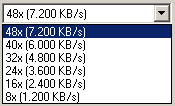
According to Nero CDSpeed, the drive confirmed the maximum 48X speed. The
test started at 21.62X and finished at 48.70X, having an average speed of 36.88X.
Click on the image below for an enlarged view.
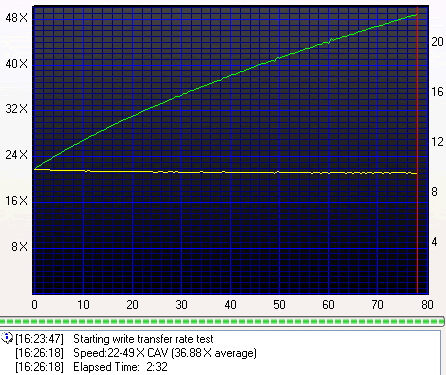
For the burning tests, we created an 80min data compilation through Nero
Burning Rom, recording the data on several 700MB discs. The drive
needed only 2:36 minutes to complete this task at the
maximum 48X writing speed.
In the following graph, we can see the recording times the 5169D reported with various CD-R media inserted.

The GSA-5169D supports 32X Z-CLV rewriting speed with Ultra Speed Rewritable Media
(US-RW).
Below you can see the output from the Nero CD-DVD Speed writing simulation test with blank
24X US-RW media from Mitsubishi Chemicals.
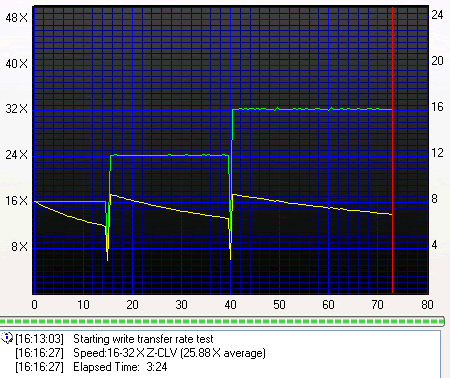
The drive starts the writing task at 16.07X and reaches a maximum of 32.15X, having an average speed of 25.88X
- Overburning Test
Unfortunately, the drive does not support overburning for the specific media.
7. CD Writing Quality - Plextools
 We measured the C1 / C2 error rate on the recorded discs we burned at the
maximum supported writing speed of 48X. The software we used is PleXTools Professional
v2.28, and more specifically the built-in Q-Check utility. The
reader was the Plextor PX-716A (firmware v1.09).
We measured the C1 / C2 error rate on the recorded discs we burned at the
maximum supported writing speed of 48X. The software we used is PleXTools Professional
v2.28, and more specifically the built-in Q-Check utility. The
reader was the Plextor PX-716A (firmware v1.09).
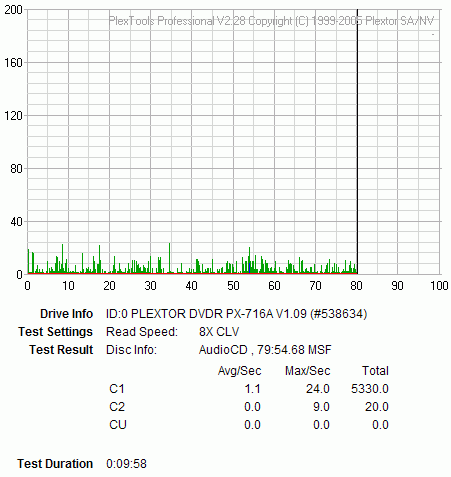
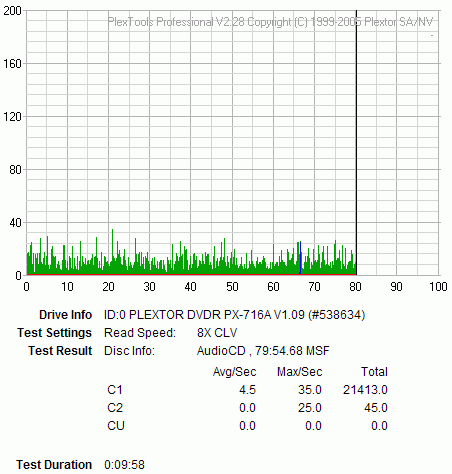
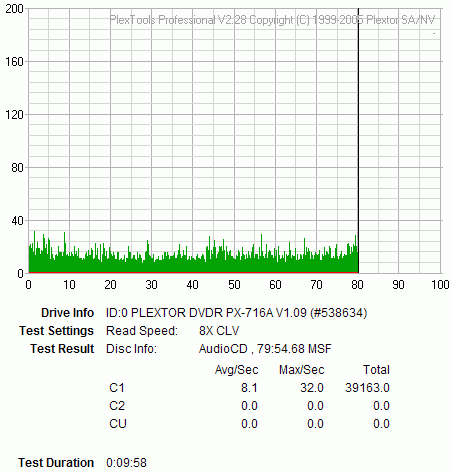
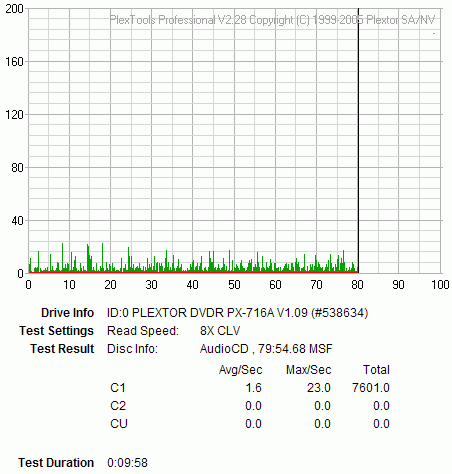

- Summary
According to the above Plextools scans, the drive produced some very good quality burns, with no C2 errors reported. But let's move on to the next page and see what the Clover CDX reports about the specific media.
8. CD Writing Quality - Clover System
Untitled Document
The Clover Systems CDX Compact Disc Analyzer is a high-speed tool to quantitatively measure the quality of a CD. It will analyze CD-DA, CD-ROM, CD-ROM XA, CD-I, CD-R, Photo-CD, Enhanced CD and CD-RW discs at 4X, 8X, 24X, 32X or 40X speed. It effectively measures disc quality by examining the quantity and severity of CIRC errors generated during playback. It also provides the capability to measure signal parameters related to pit geometry, such as asymmetry and reflectivity. Together, all these bits of information provide a thorough analysis of disc quality. The Clover Systems Analyzers can also perform various format-checking tests on data discs, and do bit-for-bit data comparison on all types of CDs. All tests are carried out at the maximum speed of 40X.
CIRC error correction uses two principles to detect and correct errors. The first is redundancy (extra information is added, which gives an extra chance to read the disc), and the second is interleaving (data is distributed over a relatively large physical area). The CIRC error correction used in CD players uses two stages of error correction, the well known C1 and C2, with de-interleaving of the data between the stages.
The error type E11 means one bad symbol was corrected in the C1 stage. E21means two bad symbols were corrected in the C1 stage. E31 means that there were three or more bad symbols at the C1 stage. This block is uncorrectable at the C1 stage, and is passed to the C2 stage. Respectively, E12 means one bad symbol was corrected in the C2 stage and E22 means two bad symbols were corrected in the C2 stage. E32 means that there were three or more bad symbols in one block at the C2 stage, and therefore this error is not correctable.
BLER (Block Error Rate) is defined as the number of data blocks per second that contain detectable errors, at the input of the C1 decoder. Since this is the most general measurement of the quality of a disc, you will find BLER graphs for all media tested below. If you click on the images you can see a more detailed table, indicating error levels. The Red Book specification (IEC 908) calls for a maximum BLER of 220 per second averaged over ten seconds. Discs with higher BLER are likely to produce uncorrectable errors. Al low BLER shows that the system as a whole is performing well, and the pit geometry is good. However, BLER only tells us how many errors were generated per second, and it does not tell us anything about the severity of those errors.

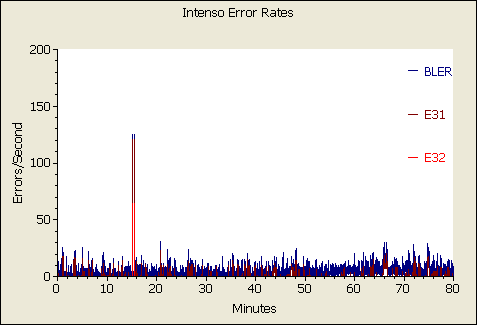

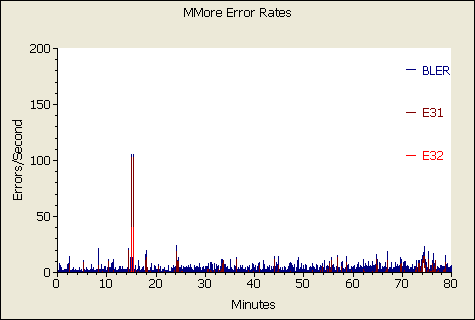

- Summary

According to the CDX Clover Systems Quality Check measurements, none off the above CD media, burned with the GSA-5169D, managed to meet the quality criteria in order to pass the test. Unlike the results reported when using the Plextools Professional Q-Check feature, the CDX did not award any pass grade to any of the 5 burned media.
9. DVD Writing Tests
- Writing Performance
The maximum supported speed is 16X CAV for both DVD+R and DVD-R formats. For DVD+RW, the speed is 8X while for DVD-RW, 6X.
By using Nero CD-DVD Speed with DVD-R and DVD+R media, we are able to see the writing strategy of the drive for both formats at 16X burning speed.
-
16X DVD+R Single Layer writing

The drive completed successful DVD writing at 16X in 6:22mins.
The test started at 6.67X, reached a maximum writing speed of 12.60X and
reported an average speed of 11.58X. The max reported speed reached, is due to the drive dropping its burning speed near the completion of the test, right after the last WOPC walk took place. Note here, that in order to ensure the validity of the tests, the Create Data Disc test was carried out twice.
- 16X DVD-R Single Layer writing

The drive completed successful DVD writing at 16X in 5:40mins. The test started at 6.68X, reached a maximum writing speed of 15.40X and reported an average speed of 11.68X. Once again, the writing was a litle jerky near the end.
- Burning Tests
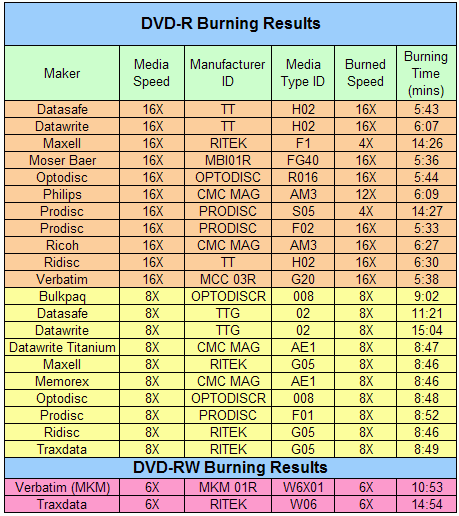
We burned a variety of DVD-R media which were 16X and 8X certified. Almost all media were burned at their indicated speeds, with the exception of Maxell, Prodisc (S05) burned at 4X, and Philips 16X media burned at 12X. The 16X writing times were fast, requiring 5:36min with Moser Baer media.


With 16X and 8X certified media, all media were burned at their indicated speeds. Best burn (completion time) was Maxell 16X media, burned in 5:43mins.

- Comparison with other drives

There is a small difference in the times between the LG and Samsung drives, while the LiteOn drive was a good deal slower.

With Rewritable media, the reviewed drive was much slower than the Samsung while the LiteOn was left floundering.
- DVD Overburning Test
Unfortunately, the drive does not support DVD overburning for both -R and +R media formats.
- DVD-RAM
Now we will see how the drive performs when a DVD-RAM media is inserted. According to the manufacturers specs, the drive can read and write DVD-RAM media, with the max speed of 5X.
As Maxell stated: "DVD-RAM is an advanced recording media format that offers a range of digital data applications. Its phase-change recording material allows discs to be re-recordable and erasable, and a superior defect management system ensures accurate recording and playback. DVD-RAM allows instant, random access to any location on the disc for fast and easy data reading and writing. Because DVD-RAM supports fast formatting and no finalizing, it is an extremely easy-to-use media. And with DVD-RAM, changes can be made directly on the disc without the need to transfer data to a hard drive first, speeding up the editing tasks..."
- Burning Tests
Using NeroCDSpeed, we got the following graph:
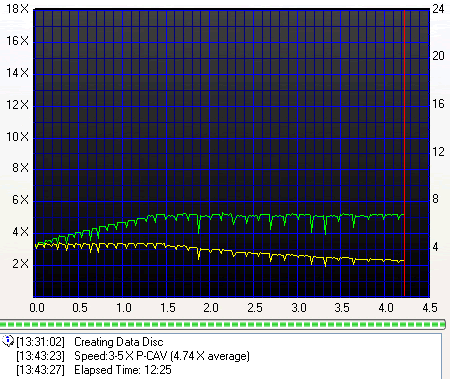
The test started at 3.21X burning speed and was completed in 12:25 mins with a max speed of 5.12X and a reported average speed of 4.74X. Note here that in the create data disc test, the drive does not enable the WOPC with the DVD-RAM. If we were to write the same amount of data with the Nero and a DVD-RAM media, it would take 30mins more or less for a full burn.
10. DVD Writing Quality - Page 1
In order to test the writing quality and readability of the burned media we
used two readers with two software applications:
- The LiteON SOHD-167T with patched firmware being able to read DVD5 up to 16X CAV and DVD9 up to 10X CAV. For the transfer rate tests we used the latest Nero CDSpeed version.
- The Plextor PX-716A with the latest available firmware. For scanning the disc, we used the latest PlexTools version at 2X CLV reading speed, BURST mode, with middle accuracy.
In general, a "perfect" disc should have a smooth reading curve,
very low PIE/POE and zero (0) POF error rates. Most times however, even though
a disc has very low PIE/POE error rates, the reading curve may not be smooth
containing dropoffs. Due to the fact that we overspeed the reading capabilities
of the LiteON SOHD-167T, such drops are expected, especially near the outer
area of the disc.
The measurements below should be taken not as the absolute criteria of the burning quality, but as an indication level.
16X DVD+R Writing Speed
- BenQ 16X DVD+R @ 16X


- Datawrite Titanium 16X DVD+R @ 16X


- Datawrite Yellow 16X DVD+R @ 16X


- Maxell 16X DVD+R @ 16X


- Optodisc 16X DVD+R @ 16X


- Prodisc(R04) 16X DVD+R @ 16X


- Ricoh 16X DVD+R @ 16X


- Ridisc 16X DVD+R @ 16X
 .
.

- Traxdata 16X DVD+R @ 16X


- Verbatim 16X DVD+R @ 16X


- Summary
According to Plextools, the reported quality is more than satisfactory in most cases, where we have very low PIE and POE values (zero POF of course). CD-DVD Speed shows the speed during reading, so it tends to have "messier" graphs, especially over problem areas on a disc. About half the media though, produced nice Plextor scans and very smooth CD-Speed graphs.
11. DVD Writing Quality - Page 2
In order to test the writing quality and readability of the burned media we
used two readers with two software applications:
- The LiteON SOHD-167T with patched firmware being able to read DVD5 up to 16X CAV and DVD9 up to 10X CAV. For the transfer rate tests we used the latest Nero CDSpeed version.
- The Plextor PX-716A with the latest available firmware. For scanning the disc, we used the latest PlexTools version at 2X CLV reading speed, BURST mode, with middle accuracy.
In general, a "perfect" disc should have a smooth reading curve,
very low PIE/POE and zero (0) POF error rates. Most times however, even though
a disc has very low PIE/POE error rates, the reading curve may not be smooth
containing dropoffs. Due to the fact that we overspeed the reading capabilities
of the LiteON SOHD-167T, such drops are expected, especially near the outer
area of the disc.
The measurements below should be taken not as the absolute criteria of the burning quality, but as an indication level.
8X DVD+R Writing Speed
- Bulkpaq 8X DVD+R @ 8X


- Datasafe 8X DVD+R @ 8X


-Datawrite 8X DVD+R @ 8X


- Maxell 8X DVD+R @ 8X


- Optodisc 8X DVD+R @ 8X


- Ridisc 8X DVD+R @ 8X


- TY 8X DVD+R @ 8X


- Summary
With 8X media, the drive managed to produce extremely nice burns, as we can see from the above scans from both the Plextools and CD-Speed quality check utilities.
12. DVD Writing Quality - Page 3
In order to test the writing quality and readability of the burned media we
used two readers with two software applications:
- The LiteON SOHD-167T with patched firmware being able to read DVD5 up to 16X CAV and DVD9 up to 10X CAV. For the transfer rate tests we used the latest Nero CDSpeed version.
- The Plextor PX-716A with the latest available firmware. For scanning the disc, we used the latest PlexTools version at 2X CLV reading speed, BURST mode, with middle accuracy.
In general, a "perfect" disc should have a smooth reading curve,
very low PIE/POE and zero (0) POF error rates. Most times however, even though
a disc has very low PIE/POE error rates, the reading curve may not be smooth
containing dropoffs. Due to the fact that we overspeed the reading capabilities
of the LiteON SOHD-167T, such drops are expected, especially near the outer
area of the disc.
The measurements below should be taken not as the absolute criteria of the burning quality, but as an indication level.
16X DVD-R Writing Speed
- BenQ 16X DVD-R @ 16X
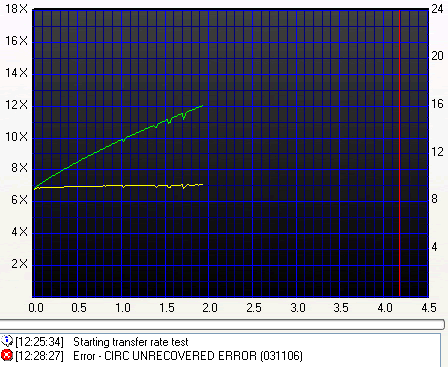

- Datasafe 16X DVD-R @ 16X
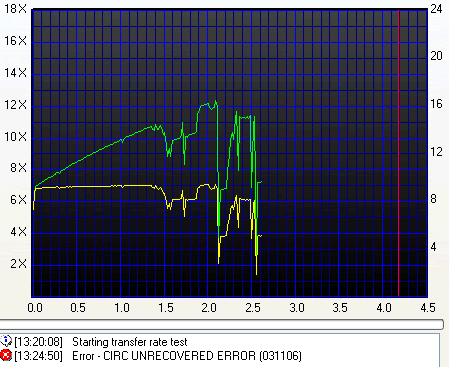

- Datawrite Yellow 16X DVD-R @ 16X

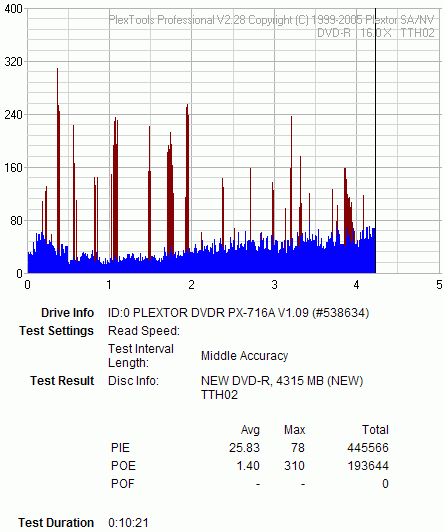
- Maxell 16X DVD-R @ 4X


- MKM 16X DVD-R @ 16X


- Moser 16X DVD-R @ 16X
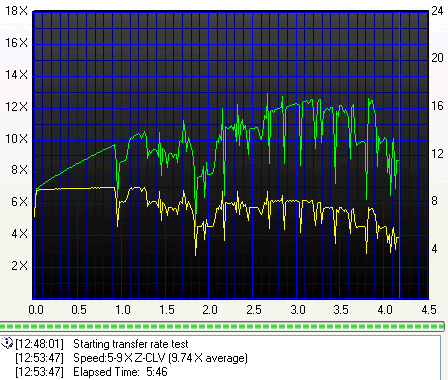
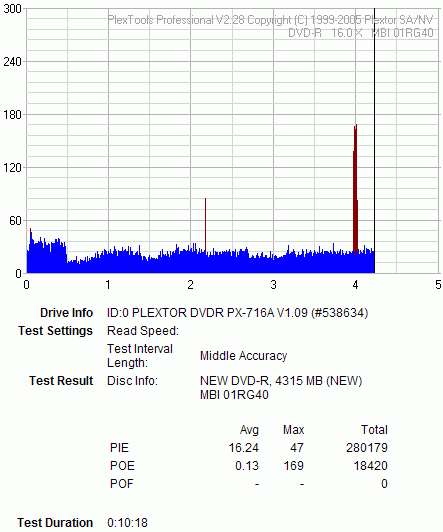
- Optodisc 16X DVD-R @ 16X


- Philips 16X DVD-R @ 12X
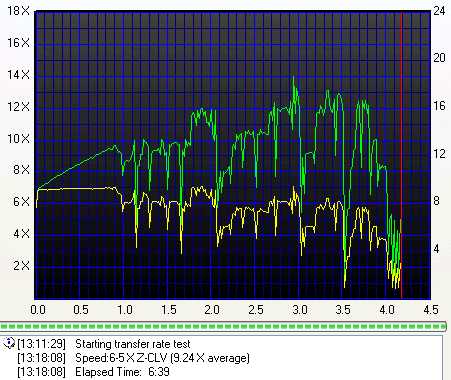

- Prodisc (S05) 16X DVD-R @ 4X

_16X_4X.png)
- Prodisc (F02) 16X DVD-R @ 16X

_16X.png)
- Ricoh 16X DVD-R @ 16X
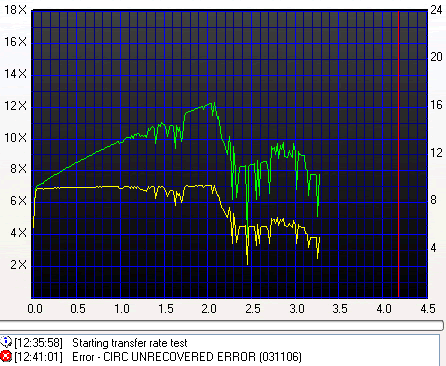

- Ridisc 16X DVD-R @ 16X

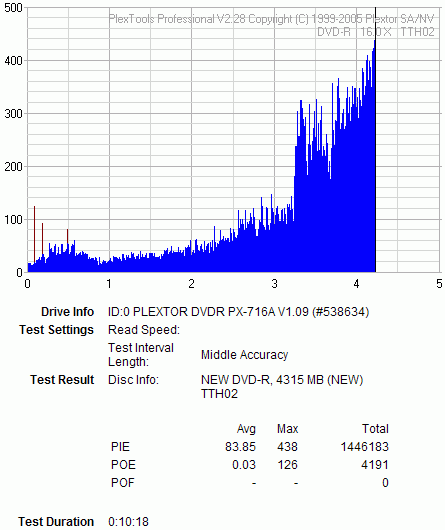
- Summary
Mixed results for the most part when using 16X-R effective media. Even though with Plextools, most media managed to produce low error values and nice readings, CD-Speed reports otherwise, with erratic graphs and in some cases, incomplete readings. The Almedio Q-check will clarify things, but a firmware upgrade addressing -R burning quality would be most welcomed.
13. DVD Writing Quality - Page 4
In order to test the writing quality and readability of the burned media we
used two readers with two software applications:
- The LiteON SOHD-167T with patched firmware being able to read DVD5 up to 16X CAV and DVD9 up to 10X CAV. For the transfer rate tests we used the latest Nero CDSpeed version.
- The Plextor PX-716A with the latest available firmware. For scanning the disc, we used the latest PlexTools version at 2X CLV reading speed, BURST mode, with middle accuracy.
In general, a "perfect" disc should have a smooth reading curve,
very low PIE/POE and zero (0) POF error rates. Most times however, even though
a disc has very low PIE/POE error rates, the reading curve may not be smooth
containing dropoffs. Due to the fact that we overspeed the reading capabilities
of the LiteON SOHD-167T, such drops are expected, especially near the outer
area of the disc.
The measurements below should be taken not as the absolute criteria of the burning quality, but as an indication level.
8X DVD-R Writing Speed
- Bulkpaq 8X DVD-R @ 8X

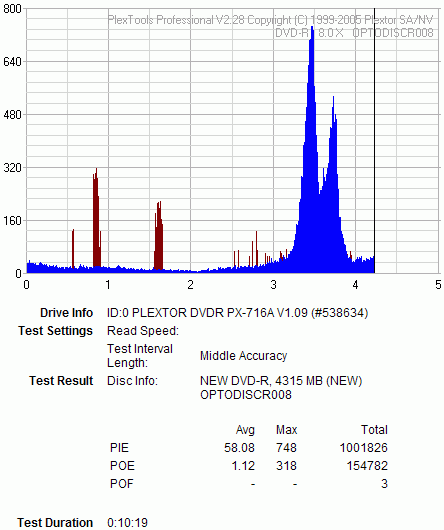
- Datasafe 8X DVD-R @ 8X
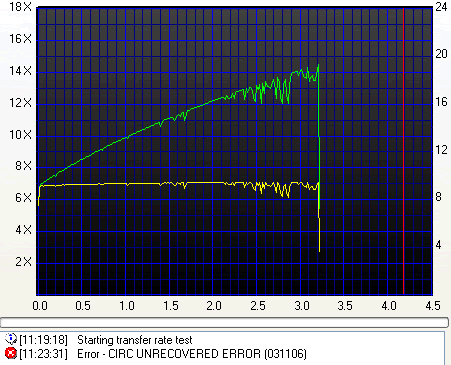

- Datawrite Titanium 8X DVD-R @ 8X
-R_8X.png)
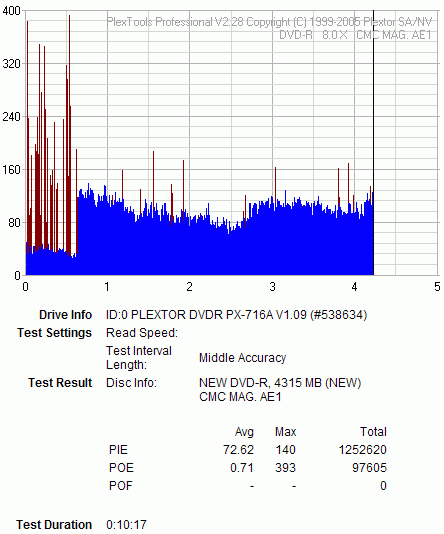
- Datawrite Yellow 8X DVD-R @ 8X
-R_8X.png)

- Maxell 8X DVD-R @ 8X
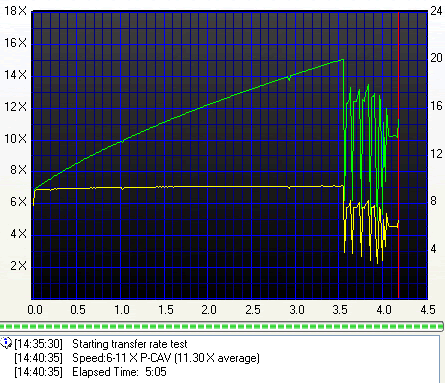

- Memorex 8X DVD-R @ 8X
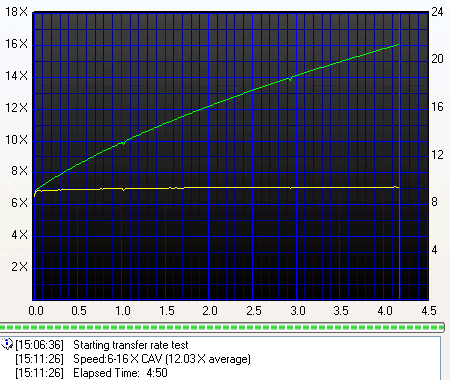
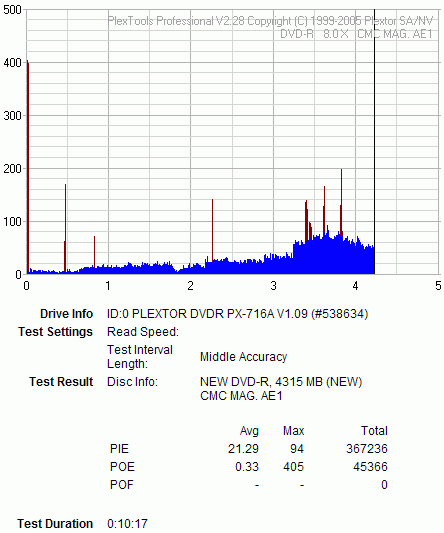
- Optodisc 8X DVD-R @ 8X


- Prodisc 8X DVD-R @ 8X


- Ridisc 8X DVD-R @ 8X


- Traxdata 8X DVD-R @ 8X


- Summary
Performance with 8X is certainly better than with 16X. Here too though, we had a case (Datasafe) where CD-Speed could not read the entire disc.
14. DVD Writing Quality - Page 5
In order to test the writing quality and readability of the
burned media we are used two readers with two software applications:
- The LiteON SOHD-167T with patched firmware being able to read DVD5 up to 16X CAV and DVD9 up to 10X CAV. For the transfer rate tests we used the latest Nero CDSpeed version.
- The Plextor PX-716A with the latest available firmware. For scanning the disc, we used the latest PlexTools version at 2X CLV reading speed, BURST mode, with middle accuracy.
In general, a "perfect" disc should have a smooth reading curve,
very low PIE/POE and zero (0) POF error rates. Most times however, even though
a disc has very low PIE/POE error rates, the reading curve may not be smooth
containing dropoffs. Due to the fact that we overspeed the reading capabilities
of the LiteON SOHD-167T, such drops are expected, especially near the outer
area of the disc.
The measurements below should be taken not as the absolute criteria of the burning quality, but as an indication level.
6X, 8X ±RW Writing Speed






- Summary
Unfortunately, the reported quality for the burned RW media is not satisfactory. Note also, that we tried to burn a Ricoh +RW 8X disc with the drive, but the media did not pass neither CD-DVD Speed nor Plextools Q-chekcs.
15. DVD Writing Quality - Almedio
The AEC-1000 consists of a DVD Drive and the "ALChecker" error measurement application which can check the written data quality. The application is capable of 1X CLV measurements as well as 4X CLV on DVD-Video/ROM and finalized DVD+R/-R media.
There are three measurement modes:
- Fine Mode: checks a series of eight consecutive ECC blocks,
- Rough Mode: checks eight consecutive ECC blocks every 100h ECC blocks
- Quick Mode: checks three specified areas
The checking status is shown graphically. The reported errors are the PI and the UncPO. In the case of PI, it counts the number of rows corrected by the PI error correction in each group of eight consecutive ECC blocks. In the case of UncPO, it counts the number of ECC blocks in which more than one byte is uncorrectable in eight consecutive ECC blocks. For our quality scans, we set for 1X CLV and Fine Mode which is the slowest and with the safest results. Also, we chose to measure all the media burned at the maximum available writing speed, namely 16X.
- Ricoh 16X DVD+R @ 16X

- Prodisc S05 16X DVD-R @ 4X

- MKM 16X DVD-R @ 16X

- Moser Baer 16X DVD-R @ 16X

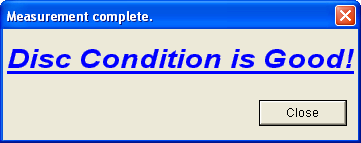
- Ridisc 16X DVD+R @ 16X

- Maxell 16X DVD-R @ 4X

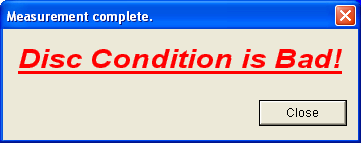
Four out of six burned media were found to be of good quality. Unfortunately, Maxell burned at 4X and Ridisc burned at 16X, were found to be of bad quality, reporting 1 UncPO error value.
16. DVDR DL - Page 1
 We burned some DVD+R DL and DVD-R DL discs with data content. For this task we used "Create Data Disc" from Nero CDSpeed in order to fully burn the discs.
We burned some DVD+R DL and DVD-R DL discs with data content. For this task we used "Create Data Disc" from Nero CDSpeed in order to fully burn the discs.
MKM DVD+R DL 8X @ 8X

The drive started burning the media at 4.02X and maxed out at 8.05X with and average of 6.34X using ZCLV writing strategy. The burn time was 19.07mins.
Ricoh DVD+R DL 8X @ 8X

Unfortunately, the drive could not complete the create data disc function.
Verbatim DVD-R DL 4X @ 4X

The test started at 4.02X and writing speed maxed out at 4.03X with an average speed of 3.98X, completing the burn in 27:11mins.
17. DVDR DL - Page 2
In order to test the LiteOn SHM-165P6S DL writing quality, we used the LiteOn SOHD-167T and the Plextor PX-716A drives, to scan the burned media.
MKM DVD+R DL 8X @ 8X

Unfortunately, the Plextor drive could not read the specific media, even though the LiteOn drive managed to read both layers with a slight drop in speed during the layer change.
Verbatim DVD-R DL 4X @ 4X


Average to good burning quality is reported here, according to both CD-Speed and Plextools utilities, at 4X burning speed.
- Summary
A new firmware release addressing DL media compatibility and burning quality is in order. Overall, average DL burning capabilities.
18. One Touch Function
The LG GSA-5169D offers the One Touch function, which enables the end user to capture Video from his VCR or Camera straight to a blank DVD disc. This function is quite easy to master, as OneTouch provides an extremely easy to work with Wizard for the beginner, as well as a more advanced layout of the program and its functionality, for the more demanding and advanced users.

In order to use OneTouch Recording, you have to use a composite audio/video cable or an S Video cable (not included in the package) which transfers Audio and Video from the video input device to the burner.
1. After installing the One Touch application from the installation CD included, double clicking on the shortcut icon and choose whether you want to use the easy wizard or the advanced option.

2. The wizard is very simple and within a few clicks, you can have your DVD ready in no time. The program will also prompt you, if no blank media is inserted.

3. The Advanced User functionality is a bit more complicated, and the end user must choose from the available options, which includes the drop down menu to select the input source for the video. This choice auto-detects video input devices and lists them. Any and all attached capture devices will be listed here.


As we can clearly see from the above snapshots, the advanced user interface also allows for the choice of the format which will be used in the capture, the Video Type (NTSC - PAL) and the quality, which is the main factor in determining the size of the captured file.

4. Next step is the Editing. If the user wants to customise the captured Video, including applying some special effects, he can do so here.

5. Last step is to burn the captured Video. Choose between PAL or NTSC for the Video format and set the burning speed. The user can't choose the burner, since the only one available will be the GSA-5169D.
That concludes this brief presentation of the OneTouch Feature offered with the LG GSA-5169D.

19. Booktype Setting
The drive supports the booktype change through Nero Burning Rom. The user can change the setting to the one that suits his needs, from the drive's properties dialog. Note here, that the changes will be saved and applied every time thereafter, a +R +RW +R DL disc is inserted and burned with the Nero burning utility.

20. Conclusion
 The LG GSA-5169D is one of two latest release external DVD Burners solutions from LG. Unlike the LG GSA-2166D (a review of which is to be released soon by CDRinfo), the 5169D does not support LightScribe technology. Of course, it supports all the well known media formats, being a Multi drive, at the fastest available speeds (excluding DL media where the max burning speed for -R DL media is still only 4X). But what makes the 5169D a unique release, is the "One Touch Rec" feature. Before going on to discuss this specific function, let's recap on the drive's performance.
The LG GSA-5169D is one of two latest release external DVD Burners solutions from LG. Unlike the LG GSA-2166D (a review of which is to be released soon by CDRinfo), the 5169D does not support LightScribe technology. Of course, it supports all the well known media formats, being a Multi drive, at the fastest available speeds (excluding DL media where the max burning speed for -R DL media is still only 4X). But what makes the 5169D a unique release, is the "One Touch Rec" feature. Before going on to discuss this specific function, let's recap on the drive's performance.
As far as reading speed is concerned, the drive performed quite well. The 48X max supported reading speed for pressed media is the least one would expect from a latest generation drive. But the most impressive performance was with write once DVD media, where the drive supports a max speed of 16X, whereas most of the market drives only support up to 12X max with the specific media. With DL media, 8X was the max supported speed.
Unfortunately, the drive could not read our 90mins audio disc but could read the 99min. Ripping speed was satisfactory, compared with the other two external drives in our comparison.
In the Error Correction arena, the drive produced average to good performance with CD media, and good with DVD media. Note here, that with the ABEX TDR-841 DVD test media, the drive failed to read over the defective area, reporting read errors. This is a performance we haven't witnessed for some time now, especially from an LG drive, where we have been used to excellent error correction.
With protected media, the drive managed to achieve good results while reading the protected games discs but alas, the 5169D wasn't able to rip all the latest protected games. With audio CDs, performance was more or less the same, as the drive failed to rip the Key2Audio protected disc, but managed to rip successfully and at a fast speed, the CDS200 and CDS 200.0.4 - 3.0 build 16a protection schemes.

Moving on to the burning capabilities of the drive and starting with CD media, according to the first Plextools scans, we could talk about increased quality, as almost all of the five media burned reported extremely low error levels and no C2 errors whatsoever. But when we double check with the CDX quality check utility, the results were far from satisfying. None of the inserted media was awarded a pass grade, all resulting in a "fail". As far as DVD burning quality is concerned, we were pleased to see that most of the inserted media were burned at their certified speeds with a few exceptions. Note here, that the drive has a "liking" towards the +R media format, performing better with that format. What we didn't like, was the fact that the drive could not perform with certain DL media, as it can be seen in the pages of this review. With RW media, the performance was average as indicated by both Plextools and CD-Speed Q-check utilities.
No changes in the DVD-RAM scene, with the drive reading and writing at 5X, while with Nero, and WOPC enabled, the drive will fill a full DVD-RAM in 25+mins.
Bitsetting is also supported through the automated feature from Nero Properties.
Concluding, we will say a few words about the One Touch feature available with the GSA-5169D. With this feature, the user can capture video straight to a blank DVD disc, through the supported Composite Audio/Video or SVideo i/o connected to his VCR, Video Camera or other similar device. With the use of easy wizard or an advanced users interface, all facets of producing a DVD can be handled.
The price at the time of this review for the retail package was around US$160 from pricegrabber.com
- The Good
- High reading speed for DVD-R and DVD+R media
- OneTouch feature
- Fast writing times at 16X
- Bittsetting for all media (+R, +RW, +R9)
- The Bad
- Doesn't accurately backup SafeDisc2 v2.9x+ protected discs
- Cannot successfully rip the Key2Audio protected scheme
- Doesn't support CD/DVD overburning
- No Audio/Video cables in retail package
- Like to be fixed
- DVD writing quality with specific media
| Retail Package |
 |
| Reading |
 |
| Error Correction |
 |
| Protected Discs |
 |
| Writing |
 |
| Features |
 |